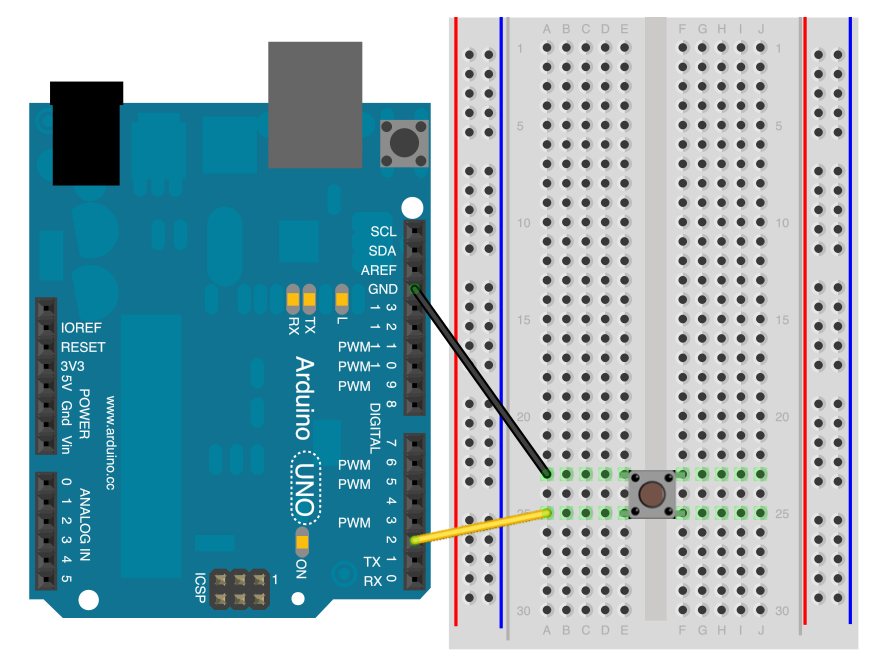How To Repair Screen On Pella Storm Door With Pull Down Half Glass
Take any digital electronic circuit and chances are you'll observe pull-up and pull-downwards resistors in them. Well, as for whatsoever microcontroller (East.g. Arduino) in an embedded organization, it utilizes I/O signals for communication with external hardware devices, where the about commonly known being GPIO. And when in that location's nothing connected to your GPIO pins, your program will read a "floating" impedance land, which nosotros practise not want. To achieve either "high" or "low" states, we'll have to implement pull-up or pull-downwards resistors in our digital circuit.
Hence, in today's comparison guide, we'll take a look at what are pull-up and pull-down resistors, its' differences and an Arduino guide.
- If y'all wish to find out more virtually resistors in full general, and how to color decode them, you tin cheque out my earlier guide here
What is Pull-up Resistors and it's purpose

Pull-up resistors are fixed value resistors used between the connexion of a voltage supply and a detail pivot in a digital logic excursion. More than commonly paired with switches, its purpose is to ensure the voltage betwixt Ground and Vcc is actively controlled when the switch is open. Additionally, non affecting the country of the circuit when doing so as well. Do understand that if at that place aren't pull-upwards resistors, it'll outcome in a short excursion, which isn't ideal.
Pull-up resistors applications
- Interfacing device betwixt a switch and a microcontroller board
- Analog to digital convertors,; providing a controlled current menses into a resistive sensor
- I2C protocol coach; allow a single pin to act equally an I/P or O/P
When to utilize pull-up resistors?
If you crave a Low default impedance country and wish to pull the signal to "loftier", pull up resistors are the ones to use.
What is Pull-down Resistors

Similarly to pull-up resistors, pull-down resistors ensure the voltage betwixt VCC and a microcontroller pivot is actively controlled when the switch is open. Notwithstanding, instead of pulling a pin to a high value, such resistors pull the pin to a low valued instead. Though being less commonly used, a pull-downward resistor is nevertheless a valid choice.
How to calculate values for Pull-up and Pull-down Resistors
With many pull-up or pull-down resistors in digital logic level circuits ranging from two to four.7k, we'll need to calculate the bodily values of these resistors. Similarly to how we calculate resistance for a normal resistor, we'll utilise the formula in Ohms law, where R = Voltage/Electric current or in brusque, R = V/I
Computing actual values for pull-up resistors
For pull up resistors, voltage refers to the source voltage minus minimum voltage accustomed every bit high. While the current refers to the maximum current sunk by the logic pins.
Formula for computing bodily value for pull-upwards resistors:
- R pull-upwardly = (V supply – VH(min)) / Isink
Computing bodily values for pull-downwards resistors
For pull-down resistors, in that location's a slight modify to the formula, though it'due south still based on Ohms law. Voltage will know be referred to logic Low, while the current refers to the maximum current sourced by the digital pin.
Formula for calculating bodily value for pull-down resistors:
- R pull-down = (VL(max) – 0) / Isource
Pull up resistor vs pull downward; The Differences
To better illustrate the differences between pull-upward and pull-down resistors, I'll be providing a side-to-side comparison through a tabular array below:
| Pull-Up Resistors | Pull-Downwards Resistors |
|---|---|
| Connect betwixt I/O pivot and +supply voltage, with an open switch connected betwixt I/O and ground. Keeps the input "High" | Connect betwixt an I/O pin and ground, with an open up switch connected between I/O and +Supply. Keeps the input "Low" |
| More commonly used | Less commonly used |
As observed, at that place aren't much differences between both type resistors as they share vastly similar functionality.
Arduino Internal Pull-up Resistor Tutorial
The post-obit tutorial demonstrates how you lot can use INPUT_PULLUP with pinMode(), past monitoring the state of a switch through establishing a serial advice between your Arduino and PC.
Here'southward what y'all need for this tutorial:
- An Arduino Board
- Switch, push, or toggle switch
- Breadboard
- Wires
Hardware Configurations:

- Connect two wires to the Arduino board
- Blackness wire connects ground to one leg of the pushbutton
- 2nd wire connects digital pivot 2 to the other leg of the pushbutton
Software Configurations with Arduino Lawmaking
- Step i: Found 9600 bits of data betwixt your Arduino and your PC by entering the code below:
Series.begin(9600); - Step 2: Initialize digital pin 2 as an input with the internal pull-upwards resistor enabled:
pinMode(2,INPUT_PULLUP); - Pace three: Enter the post-obit line, making pivot 13, with the onboard LED an output
pinMode(thirteen, OUTPUT); - Footstep 4: Establish a variable to agree the information coming in from your switch:
int sensorValue = digitalRead(2); - Stride v: In one case your Arduino has read the input, arrive print this information dorsum to the computer by entering this code:
Serial.println(sensorValue, Dec); Now, when you open your Serial Monitor, you'll see a stream of "0" if your switch is closed and a stream of "i" if your switch is open. The LED on pin 13 will illuminate when the switch is "High", and turn of when it's "Low" also.
- For the full Arduino code, you can head hither
Summary
That'southward all for today on pull-up resistors. I promise with today's web log, yous get a deeper understanding of what is a pull-upwards resistor, the differences between pull-up and pull-downward, aslope interfacing with an Arduino board!
- Recall, the key part of a pull-up resistor is to prevent input lines from floating!
Source: http://www.seeedstudio.com/blog/2020/02/21/pull-up-resistor-vs-pull-down-differences-arduino-guide/
Posted by: harrissher1970.blogspot.com


0 Response to "How To Repair Screen On Pella Storm Door With Pull Down Half Glass"
Post a Comment